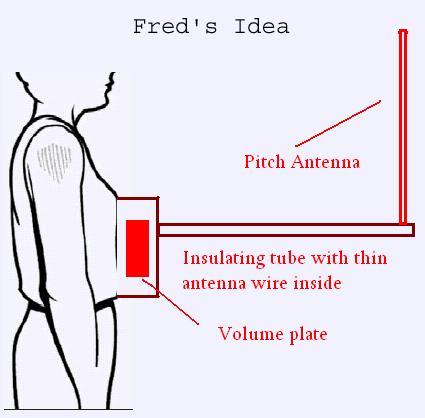From Here:
"bound to ground"
LOL;-)
Not strictly true though..
You dont actually need ground - you just need to be a capacitor 'plate' connected to the theremins 'ground'... We use ground because generally its the most common medium of conduction or capacitive coupling between the theremin / environment / player..
But connect the "ground wire" (from the theremin) directly to the theremin player, and the need for "ground" completely disappears! - You can have a battery powered theremin completely disconnected from "ground" provided the thereminist is connected to the 'ground side' of its circuitry.
Somewhat OT - TECHNICAL - And, astoundingly, controversial:
But its kinda risky saying something obvious like this here - because there are folks who turn it into pages of utter nonsense (will even paste pages from theremin instruction manuals where Bob Moog says the theremin must be connected to ground, Take Bobs words out of context, and say that as I am "contradicting" Bob, I must be talking BS) and (effectively) claim that "ground" has special mystical qualities, and that unless you put stakes in the ground or otherwise ensure a physical connection to "real" ground, the theremin wont be a "real" theremin, and will lose its quality of sound.. All such claims are pure bullshit!
What the theremin sensing principle is, how it works, the basis on which the theremin world rotates is this:
There is a circuit comprising of an inductor and capacitor forming a tuned circuit. The capacitor sits across or in series with the inductor - one end of this capacitor is tied to the theremins "common" (0V)* the other end is connected to the antenna.. Another capacitor is across this capacitor, this capacitor is you,the thereminist, and your capacitive 'bulk' coupling to the antenna ... One end of you needs to be connected to the "common" so that you can be in parallel with the capacitor inside the theremin..
IF the theremins "common" is connected to ground, and you couple to ground strongly, everything works.. If the theremin isn't connected to ground or you dont couple to ground well, things dont work well.
IF however, you actually connect a wire between yourself (or have a separate plate from the theremins common which capacitively couples strongly to you) and the theremins "common" then you are directly "in the circuit" and everything behaves, regardless of what else the theremins "common" is connected to, or even if this "common" isn't connected to anything other than you!
Fred.
*The above is a simplification in some cases - Sometimes the antenna coupling to the player is the only 'physical' capacitor in the circuit, and there are other "capacitors" formed between the antenna and the theremins board, or if the theremin is connected to ground, between the antenna and ground.
Also, ground is big - really really big! ;-) In fact, its Earth, and everything connected to Earth! .... So every theremin (like every conductive object within about a million miles of the center of earth) is coupled to "ground" in some measurable way... But none of this matters - If the thereminist is wired or strongly coupled to the theremins common.
(The above is the usual way theremins are operated)
To clarify the above crappy diagrams:


